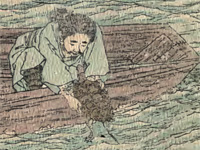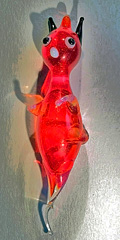tortoise and turtle
クイズそのいち) 「浦島太郎[うらしまたろう]」で、助けてもらったカメは「turtle」か「tortoise」のどっち? 答えは「turtle」。海の深いところにある竜宮城[りゅうぐうじょう]まで浦島太郎[うらしまたろう]を連れてってあげたんだもんね。
 陸亀が tortoise で海亀が turtle、というふうに明確に二分されているなら、浦島太郎が助けた亀は turtle であって、tortoise と書けば、その答案は×になるだろう。
陸亀が tortoise で海亀が turtle、というふうに明確に二分されているなら、浦島太郎が助けた亀は turtle であって、tortoise と書けば、その答案は×になるだろう。
ところが、お雇い外国人チェンバレンが訳した浦島太郎では、tortoise となっている。長谷川武次郎による挿絵も海亀には見えないが、これはとりあえず英語と関係がない。
Well, one day he went out in his boat to fish. But instead of catching any fish, what do you think he caught? Why! a great big tortoise, with a hard shell and such a funny wrinkled old face and a tiny tail. Now I must tell you something which very likely you don’t know; and that is that tortoises always live a thousand years, at least Japanese tortoises do.
The Fisher-Boy Urashima, translated by B. H. Chamberlain, 1886
ついでに、ジョンソン博士の辞書も見ておくと、
tortoise Animal covered with a hard shell : there are tortoises both of land and water.
turtle It is used among sailors and gluttons for a tortoise.Samuel Johnson, A Dictionary of the English Language, 1755
サミュエル・ジョンソン(1709-1784)とチェンバレン(1850 – 1935)は、どちらもイギリス人だった。
